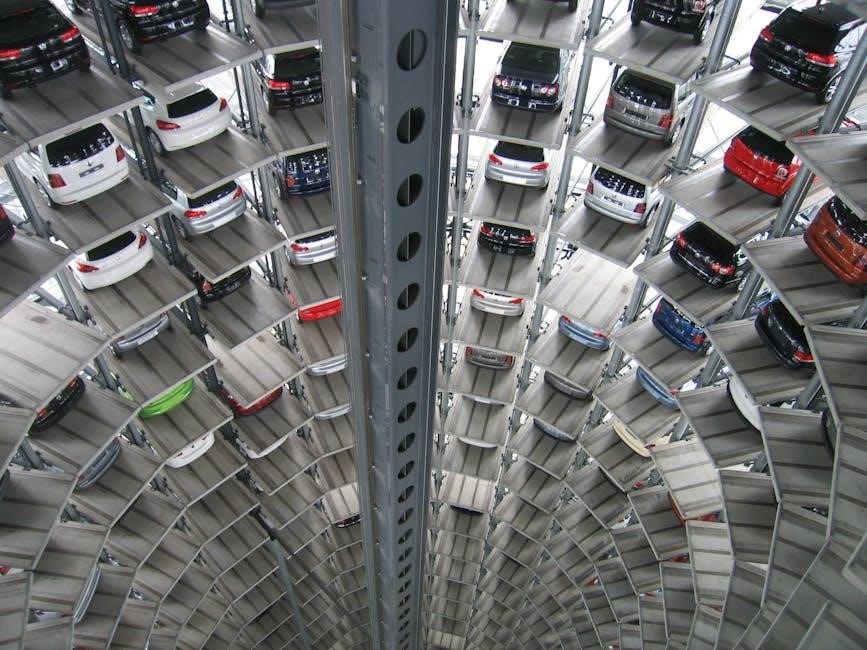Heat and mass transfer are essential processes in engineering and science, governing energy and material transport. The 8th edition provides comprehensive insights, updated methods, and practical applications for modern problem-solving.
Overview of Heat and Mass Transfer
Heat and mass transfer are fundamental processes that describe the transport of energy and matter in various systems. Heat transfer occurs through conduction, convection, and radiation, while mass transfer involves diffusion and convection. These principles are crucial in engineering, physics, and chemistry, enabling the design of efficient systems, from heat exchangers to chemical reactors. The 8th edition of this text provides a detailed exploration of these phenomena, offering insights into their underlying mechanisms and practical applications. By understanding these processes, engineers and scientists can optimize performance, enhance efficiency, and solve complex problems across industries. This edition updates classic theories with modern advancements, ensuring relevance to current technological challenges.
Importance of the 8th Edition
The 8th edition of “Fundamentals of Heat and Mass Transfer” is a landmark resource, offering a refined and comprehensive understanding of these critical engineering disciplines. It incorporates the latest research, updated examples, and enhanced pedagogical tools to improve learning. The edition addresses emerging challenges in energy, environmental, and technological fields, providing practical insights for real-world applications. New problem sets, case studies, and digital resources further enrich the learning experience. This edition is indispensable for students, researchers, and professionals seeking to master heat and mass transfer principles in a rapidly evolving scientific landscape. Its clarity, depth, and relevance make it a cornerstone text for modern engineering education and practice.

Core Concepts in Heat Transfer
Heat transfer involves the movement of thermal energy due to temperature differences, encompassing conduction, convection, and radiation. These principles are fundamental to engineering and thermodynamics.

Conduction: The Basics
Conduction is the transfer of heat through a material without the movement of the material itself. It occurs due to the vibration of molecules and the transfer of kinetic energy from one particle to another. Fourier’s Law of Heat Conduction governs this process, relating the heat flux to the temperature gradient. Conduction can occur in solids, liquids, and gases, though it is most significant in solids. The conductivity of a material determines how easily heat passes through it. Factors such as temperature difference, material properties, and surface area influence the rate of heat transfer. Understanding conduction is crucial for designing thermal insulation, electronic cooling systems, and heat exchangers. Real-world applications include cooking, building insulation, and electronic device thermal management.
Convection: Principles and Applications
Convection involves the transfer of heat through the movement of fluids. It occurs due to the circulation of fluid caused by temperature differences, where warmer, less dense fluid rises and cooler, denser fluid descends. This process can be natural or forced, with natural convection driven by buoyancy and forced convection aided by external means like fans. Newton’s Law of Cooling describes the rate of heat transfer in convection, dependent on factors like temperature difference, surface area, and fluid properties. Convection is vital in various applications, including HVAC systems, heat exchangers, and cooling of electronic devices. It also plays a significant role in meteorological phenomena and industrial processes, making it a fundamental concept in thermal engineering and design.
Radiation: Mechanisms and Significance
Radiation is the transfer of heat through electromagnetic waves, occurring in all directions and not requiring a medium. It is governed by the Stefan-Boltzmann Law, which relates heat flux to temperature and emissivity. Radiation is significant in high-temperature processes, space exploration, and everyday phenomena like solar heating. Unlike conduction and convection, radiation depends on surface properties such as emissivity and absorptivity. It plays a critical role in industrial applications, including furnaces, heat exchangers, and thermal insulation. Understanding radiation mechanisms is essential for designing efficient systems and predicting heat loss or gain in various engineering scenarios. Its principles are also applied in renewable energy technologies like solar panels and thermal imaging systems.

Mass Transfer Fundamentals
Mass transfer involves the movement of mass between systems, driven by concentration gradients. It occurs through diffusion, convection, and absorption, essential in chemical engineering and environmental processes.
Diffusion: Key Principles
Diffusion is the process by which particles move from regions of higher concentration to lower concentration, driven by random molecular motion. It is a fundamental mechanism in mass transfer, governed by Fick’s Law. The rate of diffusion depends on factors such as concentration gradients, temperature, and the properties of the medium. In gases and liquids, diffusion plays a critical role in mixing and transport processes; Understanding diffusion is essential for analyzing phenomena like odor dispersion, drug delivery, and material degradation. The 8th edition provides detailed derivations and applications of diffusion laws, enabling engineers to model and predict mass transfer in various systems accurately.
Mass Transfer by Convection
Mass transfer by convection occurs when a fluid flows over a surface, carrying mass away or bringing it to the surface. This process is driven by bulk motion rather than molecular diffusion. Convective mass transfer is influenced by factors such as flow velocity, boundary layer thickness, and concentration gradients. The mass transfer rate is often described using convective mass transfer coefficients, which depend on fluid properties and flow conditions. Practical applications include drying processes, heat exchangers, and chemical reactors. The 8th edition provides detailed analysis of convective mass transfer, including boundary layer theory and empirical correlations, enabling precise calculations in engineering design and optimization.
Heat and Mass Transfer Equations
Core equations govern heat and mass transfer, including Fourier’s Law, Fick’s Law, and energy balance equations. These form the framework for solving transfer problems.
Fourier’s Law of Heat Conduction
Fourier’s Law is a fundamental principle describing heat transfer through conduction. It states that the heat flux is proportional to the negative gradient of temperature. Mathematically, q = -k rac{dT}{dx}, where q is the heat flux, k is the thermal conductivity, and rac{dT}{dx} is the temperature gradient. This law is essential for analyzing steady-state and transient heat transfer problems in various materials. Its simplicity and wide applicability make it a cornerstone in heat transfer analysis, enabling engineers to predict heat transfer rates in solids. The 8th edition provides detailed derivations and applications of Fourier’s Law, enhancing understanding of conduction phenomena.
Fick’s Law of Diffusion
Fick’s Law describes the rate of mass diffusion due to concentration differences. It states that the diffusion flux is proportional to the negative gradient of concentration. Mathematically, J = -D rac{dc}{dx}, where J is the diffusion flux, D is the diffusion coefficient, and rac{dc}{dx} is the concentration gradient. This law is crucial for understanding mass transfer in gases, liquids, and solids. The 8th edition elaborates on Fick’s Law, providing examples and derivations to illustrate its application in various systems. It highlights the analogy between Fick’s Law and Fourier’s Law, emphasizing their shared mathematical structure in heat and mass transfer analysis.
Energy and Mass Balance Equations
Energy and mass balance equations are foundational tools for analyzing systems in heat and mass transfer. The energy balance equation ensures conservation of energy, accounting for energy entering, leaving, and stored in a system. Similarly, the mass balance equation enforces conservation of mass, tracking mass inflow, outflow, and accumulation. These equations are essential for solving real-world problems, such as designing heat exchangers or chemical reactors. The 8th edition provides detailed derivations and applications of these balances, emphasizing their interconnection with other principles like Fourier’s and Fick’s laws. Practical examples illustrate how to apply these equations to complex systems, ensuring accurate and efficient solutions in engineering scenarios.

Problem-Solving Techniques
Mastering problem-solving techniques is crucial for addressing complex heat and mass transfer challenges. The 8th edition introduces advanced methods, including dimensional analysis and numerical approaches, to simplify intricate calculations and promote accuracy.

Dimensional Analysis in Heat and Mass Transfer
Dimensional analysis is a powerful tool for simplifying complex problems in heat and mass transfer. By identifying key variables and their dimensions, engineers can reduce intricate equations to dimensionless groups, such as the Reynolds number or Nusselt number. This approach not only simplifies calculations but also enhances the understanding of physical phenomena. The 8th edition provides detailed examples and exercises to master this technique, emphasizing its application in both heat and mass transfer scenarios. Dimensional analysis is particularly useful in experimental design and data analysis, allowing for the scaling of results to real-world systems. It bridges theoretical concepts with practical applications, making it an indispensable skill for solving engineering problems.
Numerical Methods for Complex Problems
Numerical methods are essential for solving complex heat and mass transfer problems that cannot be easily addressed analytically. The 8th edition emphasizes techniques like finite difference, finite element, and computational fluid dynamics (CFD) to handle nonlinear equations and multi-physics phenomena. These methods allow engineers to simulate real-world scenarios, such as turbulent flow or phase change, with high accuracy. Practical examples and case studies illustrate how to apply software tools and algorithms to predict system behavior. By mastering numerical approaches, professionals can tackle intricate designs and optimizations in industries like aerospace, energy, and chemical processing. This chapter equips readers with the skills to leverage computational power for solving modern engineering challenges.
Enhancements in Heat and Mass Transfer
Enhancements in heat and mass transfer focus on improving efficiency and performance through advanced designs, materials, and technologies. This section explores innovative techniques to optimize systems.

Heat Exchangers: Design and Efficiency
Heat exchangers are critical devices for efficiently transferring heat between fluids, minimizing energy losses. The 8th edition emphasizes advanced designs, such as counter-flow and cross-flow configurations, which enhance thermal performance. Materials like stainless steel and titanium are highlighted for durability and corrosion resistance. The text also explores compact heat exchanger designs, including plate-and-frame and spiral types, which optimize heat transfer coefficients. Efficiency improvements through fouling mitigation and cleaning strategies are discussed, ensuring long-term performance. Computational tools for simulating and optimizing heat exchanger designs are introduced, enabling engineers to predict and enhance system efficiency effectively.
- Advanced geometries for improved heat transfer rates
- Material selection for extreme operating conditions
- Efficiency enhancement through design optimization
Mass Transfer Equipment: Selection and Optimization
Mass transfer equipment is pivotal for facilitating efficient transfer between phases, such as gas-liquid or liquid-solid systems. The 8th edition highlights the importance of selecting equipment based on factors like fluid properties, flow rates, and equilibrium relationships. Design considerations include contactor types, such as packed towers, spray chambers, and stirred tanks, each suited for specific applications. Optimization strategies focus on enhancing interfacial area, reducing mass transfer resistance, and ensuring uniform distribution of phases. Maintenance practices, such as cleaning and monitoring, are also emphasized to sustain long-term efficiency and performance in industrial processes.
- Selection based on fluid properties and operating conditions
- Design considerations for contactors and phase distribution
- Optimization strategies to maximize interfacial area

Real-World Applications
Heat and mass transfer principles are crucial in various industries, including power generation, refrigeration, and electronics cooling, enhancing efficiency and performance in diverse technological applications.
Industrial Applications of Heat Transfer
Heat transfer plays a pivotal role in various industrial processes, ensuring efficient energy utilization and system performance. In power plants, heat exchangers are used to transfer energy from steam to water, generating electricity. Chemical plants rely on heat transfer for reactions, separations, and material processing. HVAC systems utilize heat transfer principles to maintain temperature and air quality in buildings. Heat exchangers, such as boilers and condensers, are essential in these applications. Understanding heat transfer enables the design of safe and efficient systems, reducing energy losses and improving productivity. These applications highlight the practical importance of heat transfer in advancing industrial technologies and maintaining operational efficiency.
Practical Examples of Mass Transfer
Mass transfer is integral to various industrial and everyday processes. One common example is drying, where moisture is transferred from solids to air, as seen in food dehydration and timber seasoning. Another is liquid-liquid extraction, used in coffee brewing and chemical purification. Gas absorption, such as in air pollution control systems, relies on mass transfer to remove harmful gases. Membrane separations, like dialysis and water purification, also depend on controlled mass transfer. These applications demonstrate how mass transfer principles are applied to solve real-world problems, optimizing processes and improving efficiency in industries like food processing, healthcare, and environmental engineering.

Resources for Learning
Explore textbooks, online courses, and lecture notes for in-depth understanding. Utilize simulation tools and practice problems to reinforce concepts, ensuring a comprehensive grasp of heat and mass transfer principles.
Accessing the 8th Edition PDF
The 8th edition PDF of Fundamentals of Heat and Mass Transfer is widely available through official channels. Students and professionals can access it via university libraries or purchase it directly from the publisher’s website. Authorized sellers also provide digital copies, ensuring convenient access. To avoid unauthorized downloads, always opt for legal sources. The PDF format allows for easy readability on devices, making it ideal for study or reference. Additionally, many educational platforms offer access to this edition as part of their course materials. Ensure to verify the authenticity of the source to maintain quality and accuracy of the content.
Supplementary Study Materials
Supplementary study materials for the 8th edition of Fundamentals of Heat and Mass Transfer are essential for deepening understanding. These resources include detailed solution manuals, practice problems, and interactive simulations. Online platforms offer video lectures and tutorials that align with the textbook. Additionally, many universities provide course companions tailored to the 8th edition, featuring summaries and worked examples. Students can also benefit from downloadable slides and concept review guides. These materials are readily available on the official publisher’s website and popular educational platforms. Utilizing these resources alongside the textbook ensures comprehensive preparation for exams and real-world applications. They are designed to reinforce key concepts and problem-solving skills.
The 8th edition provides a comprehensive understanding of heat and mass transfer, serving as an invaluable resource for both students and professionals. Its detailed explanations and practical examples ensure mastery of core concepts, enabling application in diverse engineering fields. The textbook’s structured approach, combined with supplementary materials, makes it an essential tool for learning and reference. By focusing on fundamental principles and modern advancements, it prepares learners for real-world challenges and future innovations in the field.
The 8th edition of Fundamentals of Heat and Mass Transfer provides a thorough exploration of heat transfer modes—conduction, convection, and radiation—and their interplay in various systems. It delves into mass transfer principles, including diffusion and convective processes, emphasizing their relevance in engineering applications. Key equations, such as Fourier’s Law for heat conduction and Fick’s Law for diffusion, are central to the text. The book also covers energy and mass balance equations, offering a framework for analyzing complex problems. Practical examples and case studies illustrate real-world applications, while numerical methods and dimensional analysis are introduced as tools for solving intricate scenarios. This edition reinforces foundational theories while connecting them to modern engineering challenges and innovations.

Future Directions in Heat and Mass Transfer
Emerging technologies and research trends highlight the future of heat and mass transfer, with a focus on sustainability, efficiency, and innovation. Advances in nanotechnology and metamaterials promise enhanced thermal management and energy storage solutions. Renewable energy systems, such as solar panels and fuel cells, will benefit from improved heat transfer designs. Additionally, computational modeling and AI-driven simulations are expected to revolutionize problem-solving in complex systems. Innovations in mass transfer, such as advanced membrane technologies, will address environmental challenges like water purification and carbon capture. The integration of heat and mass transfer principles into interdisciplinary fields, such as biomedical engineering and aerospace, will drive groundbreaking applications. These developments underscore the evolving importance of this field in addressing global challenges.

